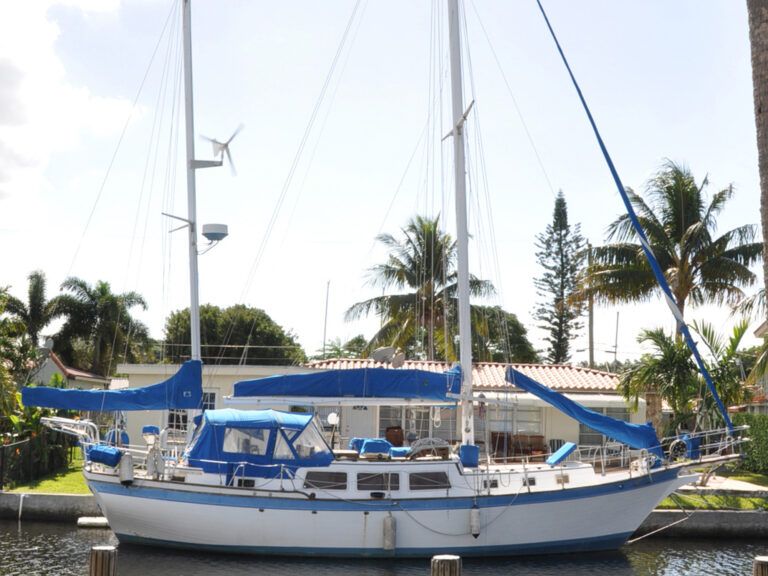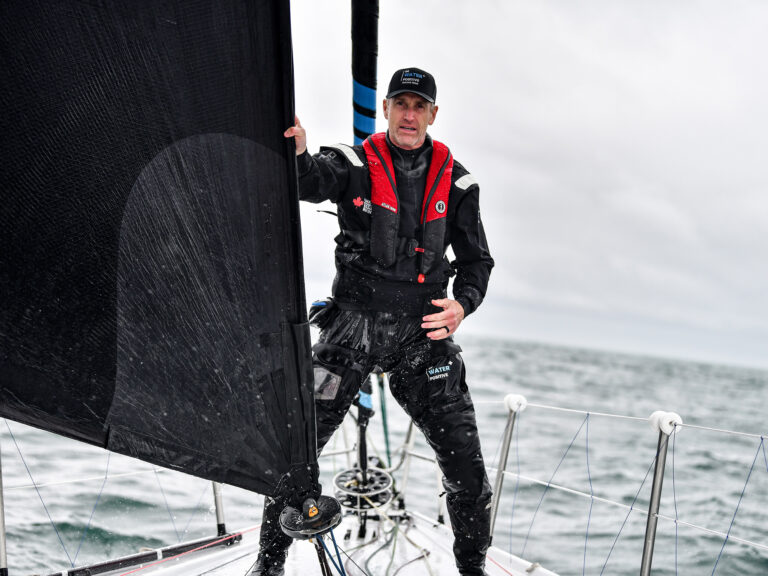Having been an avid fan of Cruising World for many years, I imagine that I fall pretty much into the mainstream demographic of its readers: sailors, boat owners, tinkerers, and would-be adventurers. I’ve owned a string of boats in various states of repair, and I savor the great days on the water. I’m always fixing and upgrading things, looking for ways to do things better and to save a buck here and there in the process. I enjoy the zen of restoring and maintaining a vessel that will take you almost anywhere if you allow yourself the time and are willing to break free. My current boat, Resound!, a 1969 Morgan 41, sails great and has taught me so much over the last decade.
Yes, I’m a cruiser. But I’m also an astronaut, and my day job-a six-month tour of duty aboard the International Space Station-has afforded me an opportunity to connect and compare two of my great passions, sailing and space travel. There have been many eureka moments.
The I.S.S. is a massive and complex structure of which the nations of the world can be proud. At the same time, it’s very much like a cruising boat, with many similarities in operation, systems, surroundings, and concerns. In space, we sail in (not on) a different ocean, but we, too, live in a world of bulkheads and stringers, plumbing and ventilation, hose clamps, through-hulls, and wiring. And we experience the same joys and occasional frustrations to which all sailors can relate. Allow me to share a few of my observations.
Getting There/Casting Off
With regard to preparation and planning for a flight into space, I.S.S. crewmembers are at the tip of a very long spear. An expansive team of people makes a huge effort to ready hardware, plan provisions, and schedule scientific work, among many other things. But personally, we keenly feel the burden of training and preparation and always wonder if we’ll really be ready. At some point, you must accept the fact that the boxes have been checked off, provisions are stowed, and the weather looks good. Despite that nagging feeling that you may have forgotten something, it’s time to go. Sound familiar?
The launch into orbit is like crossing a dangerous bar to get out into the open sea. It’s one of the more hazardous aspects of the journey, and it’s certainly where the risk has been most evident in human spaceflight. Like treacherous waves in places where currents and tides mix in less than congenial ways, the forces we respect most are encountered during launch and landing. Instead of unfriendly waters, we cross a speed barrier that gets us to altitude and orbital velocity, about 17,500 mph. It all happens in a little over eight very exciting and noisy minutes where the Earth and its clouds get smaller and more distant-quickly.
Once the engines cut off, things smooth out, and we’re coasting in low Earth orbit. Soon, some may encounter the next great ocean-voyaging malady, our equivalent of seasickness. Actually, we call it space motion sickness or, more properly, space-adaptation syndrome, but you get the idea. No hanging over the rail, though; everything goes into a bag, and since we’re now in zero gravity, what doesn’t get in the bag might float free before splatting somewhere in the ship. Over two-thirds of first-time flyers get it, but as at sea, it typically passes after a few days, and there are some medications that help.
After decades of sailing and never having been seasick, I thought I’d be pretty hardened to space motion sickness, but unfortunately for me, there doesn’t seem to be a connection between tolerance to seasickness and tolerance to airsickness. I became aware of my stomach for the first time a few hours after we arrived in zero gravity. Just as taking the helm on a boat seems to be therapeutic, keeping busy with the first couple of burn maneuvers to shape out our orbit helped keep me feeling good and functional. After that, and after taking a little medication, I kept everything inside, and I awoke the next day feeling great and with a healthy appetite.
For us station-bound souls, the launch is followed by a two-day trip to catch up with and then dock to the station. Like a small launch meeting up with its mother ship offshore, this activity requires vigilance. We have to bring two very fast-moving objects into close proximity and dampen out all the relative motion save for a small amount of closing speed. Think of the last time that you berthed under challenging conditions before a dockside audience; our docking is televised, and there’s no one to throw you a line. Most of this maneuver is automated, and there’s no wind or wave action to buffet your little ship, but things can get exciting when the automatic system switches off and you go manual. Our commander handled this maneuver beautifully and docked us right on time. Once again, a steady hand on rudder and throttle wins the day.
Being There
After docking, you float into the biggest stack of modules that’s ever graced outer space, with the approximate interior volume of a jumbo jet. We had about 10 days of overlap and handover with the current crew, who’d be returning to Earth; during this time, the learning curve was very steep. Just like getting used to relative motions and acquiring your sea legs, usually with some bumps and bruises in the process, we have to learn motion control in a whole new way. Getting your space legs especially involves learning to move from place to place without crashing into anything, which, aside from the minor scrapes, might result in what we fear much more: breaking something really expensive. But over time, we begin to settle into a shipboard routine, learning both to get from one place to another without a lot of planning and to work with a stowage and equipment setup that’s dominated by the condition of weightlessness.
A lot of our big bogies in space are common to a sailing vessel. Some of our main concerns are fires, leaks, and running into stuff (which can, of course, lead to the first two concerns). For an onboard fire, as on a boat, you fight the fire and win-or abandon ship. In both cases, you’re surrounded by a fire retardant (the ocean, for a boat) that will at some point put a stop to the event, although in our case, that retardant, basically vacuum, would also quickly put a stop to us. For a hull breach, leaks up here mean air out rather than water in. Fire extinguishers and leak-repair kits are available and inspected often, as they should be on a boat.
Although we don’t have to be on the lookout for reefs, there’s a certain amount of what we call orbital debris up here that we really don’t want to hit. Call it cosmic flotsam and jetsam, most of which consists of parts from other spacecraft. Everything in orbit is in motion, so for us, the equivalent of the chart is the radar-tracking scheme that allows the ground to warn us if we might cross paths with something solid. Compared to a reef, the things we fear are a lot smaller, typically measuring on the order of a few inches, but they move a lot faster, perhaps many miles per second in relative velocity. A collision would be more like being hit with a cannonball than heaving onto a rock. The “uncharted reefs” in orbit are a lot smaller still and below the radar-tracking threshold, but they’re still capable of doing considerable damage. Fortunately it’s still a pretty big sky, just as it’s a pretty big ocean, so the odds are definitely in our favor. But we do have lifeboats and ditch bags ready for a worst-case scenario.
Much of the routine in space involves tracking the food, water, supplies, and other things that you need to be comfortable and productive. A cruising boat carries fresh water, and many boats have watermakers to make use of the abundant but otherwise unusable water in which they travel. In space, we’re surrounded by, well, nothing. We carry our water, and we recycle it as well; yep, that means condensate: sweat and, you guessed it, today’s space pee becomes tomorrow’s beverage, or it hydrates up the mac and cheese. We also break some of our pee down into oxygen to breathe and hydrogen that we dump overboard due to its flammability.
For power, we go solar to be as minimally dependent on fuels and backup batteries as possible and because solar power is pretty abundant up here above the atmosphere. Unlike a cruising boat, which usually has small panels on the bimini or on deck, we fly about an acre of dedicated solar-array wings that track the sun and provide abundant power. These supply real-time electricity and charge our batteries when in direct sunlight, and we draw on the batteries when we’re shadowed from the sun by Earth.
Our communication system provides us a link to the Earth, which is vital to our day-to-day work and operation. Like satphones and an SSB on a cruising boat, our communication system provides us with email and contact with families and loved ones. This definitely helps with the isolation that we’d otherwise feel.
You may not think of weather as a big factor up here, but we do have our own version of this. We use the term “space weather” to describe the active and dynamic radiation environment. Just as a boat carries such rudimentary meteorological instruments as a barometer and an anemometer, we carry radiation-detection equipment to warn us of solar flares. And like a cruising boat, we also depend on remote services, in our case to give us predictions of dangerous radiation conditions. Rather than changing course or shortening sail, the crew must on rare occasions take refuge for several hours in some of the more beefier-built parts of the station that serve as better radiation shields. This is the space equivalent of heaving to during a storm.
The lack of gravity and buoyancy in space affects how gases mix-or not-as the case may be. Many are familiar with the dangers of propane, which, being heavier than air, sinks into the bilge and results in a dangerously high concentration. In weightlessness, the concentration would occur around the leak point, and only the much slower process of diffusion would move things around. This means that the oxygen you breathe would be locally consumed and that the CO2 you exhale would accumulate around you if not for forced air movement. For water and any other fluid you care about, such as fuels and coolants, there’s no gravity-driven separation, flow, or sump action. If you want gases and fluids to move, you have to move them. As such, pumps and fans abound, and the background sound of water against the hull is replaced by the constant drone of rotating machinery.
If you want to feel the wind in your face up here, you get in front of a fan outlet. If you want to see our version of the bilge, get in front of a fan inlet. It’s amazing what accumulates in these grates, which require periodic cleaning punctuated by the occasional satisfaction of finding something that’s been missing for several days.
And who’s not had memorable experiences with the venerable marine head? On Resound!, we have the fairly common rule that nothing goes in there unless you’ve eaten or drunk it first, with the exception of a small amount of approved tissue. On the I.S.S., at least for the liquids, you or your shipmates may have drunk them already several times, but since we only recycle the liquid, we don’t worry so much about clogging. Solids are collected and compacted, then burned up in the atmosphere along with other trash.
If you think using a marine head in a seaway is a persnickety business, imagine a zero-gravity toilet in which nothing falls. We depend on directed airflow to move things along. Just as at sea, discipline, alignment, timing, and technique count.
Much of our food here on the I.S.S. would be very familiar to the cruising sailor. Balanced nutritional requirements, long storage life, and ease of preparation guide food selection. We have limited freezer space, which is pretty much dedicated to preserving scientific samples (read: bits of us) for return to Earth and analysis. Food is mostly of the “heat and eat” variety, coming largely in cans and foil pouches. The pinnacle of cooking for us is rehydrating freeze-dried food packets with hot water. Visiting vehicles, such as the U.S. space shuttle and Russian Soyuz spacecraft and Progress freighter, might bring a small parcel of fresh fruit and vegetables, which we savor for a few days. But in general, the food is actually quite good and, I think, made better by the centuries-old ritual of the crew gathering around the galley table and swapping stories.
The Sensory Experience
Like most sailors, I relish the sensations of being at sea: the familiar sights of confined habitation in the midst of something much bigger, the motion of the boat, the sounds of water slapping against the hull and wind in the rigging, the aroma of salt air. Whether docked or under way at night, I awaken every so often to look, listen, feel, smell, and get a sense that all is in order. Like any ship big or small, the I.S.S. is alive with sights, sounds, smells, and vibrations. During the first few weeks on board, I’d often awaken during our sleep time to, in a similar fashion, test the senses and occasionally just float through the station.
Just as it is aboard a cruising boat at sea, it’s the presence of something unusual or the absence of something expected that now rouses me from sleep in space. One big difference is that our overall motion through space is imperceptible. The surrounding ocean dictates the motion of the boat, whereas we are freefalling while maintaining a steady altitude around Earth aboard the I.S.S.. The station does rotate, so it always flies belly to Earth, but this motion is slow, about four degrees per minute, and isn’t noticeable to us.
Leaving the Cockpit
I had the opportunity to perform a couple of space walks, or what we call in our jargon extravehicular activity. Having several times been on the bottom side of my boats for repairs or servicing while snorkeling or with scuba gear, I’d expected the E.V.A. to be similar to diving on a boat. However, the experience was overwhelmingly reminiscent of working aloft. You and all your tools must be tethered. You certainly don’t want to come loose, and if you “drop” something, it can become one of those pieces of orbital debris that might meet you later on in less-than-friendly circumstances. You also have to position yourself just right to optimize your work space, which might require some uncomfortable contortions.
The real eye-opener came during my first E.V.A. when I had to perch on the end of a telescoping boom attached to the Russian end of the station and be extended above the modules to take photos of the antennas we’d just installed. The Strela arm, as it’s called, has a bit of wobble to it when fully extended that reminded me of being up the mast in a slight breeze. I looked down at our commander who was controlling the arm with a hand crank and thought immediately of one of my teenagers on the halyard winch. Like being up the mast, you get a great view once you’ve overcome the jitters. But for me, the water was over 200 nautical miles below, with continental coastlines and cloud patterns visible. It was one of the more breathtaking experiences of this humble sailor’s life!
And there are those moments: sunsets, sunrises, and impossibly bright night skies, just as at sea. Because our orbits take about 90 minutes, we circumnavigate 16 times a day, so you might think that we’d grow indifferent to these events. But the moments come when we take a break from our tight work schedules and actually realize where we are, then pause to take it all in from the windows. From here, Earth, dominated by the seas, is indescribably beautiful. I have a few vivid memories of seeing shooting stars from the deck of my boat at night, always and ever a thrill. One night several weeks ago, I got up to float through the station, which is artificially darkened for sleep periods, and parked myself by a window during an entire night pass. I took in the stars above the horizon, lightning storms on the surface below, and, toward the end, saw a meteorite streak by. But this time, it was below me, against the background of Earth.
There are so many aspects of sailing that connect with spaceflight. Both experiences expand our reach and bring us into unique worlds. Both domains make us acutely aware of our resources and more appreciative of a well-balanced system in which there’s little margin for error. And both turn friends and acquaintances into working crew and shipmates. I’ll conclude by noting that most CW readers are probably much readier for spaceflight than they may have ever imagined.
Mike Barratt wrote and submitted this story during his first tour of duty aboard the I.S.S. last year. He’s currently training to return for his next mission, which is due to blast off (on the last flight of the shuttle Discovery) in early November.







